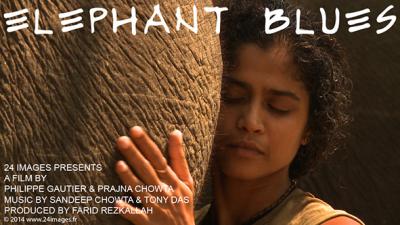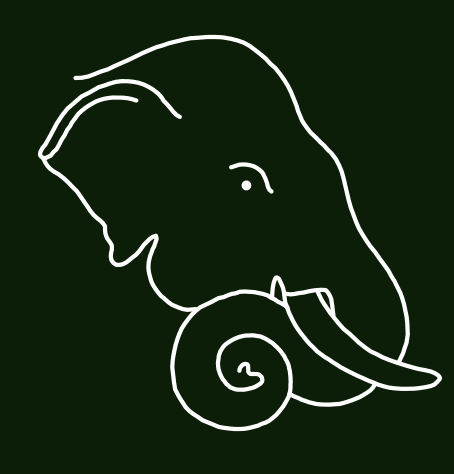
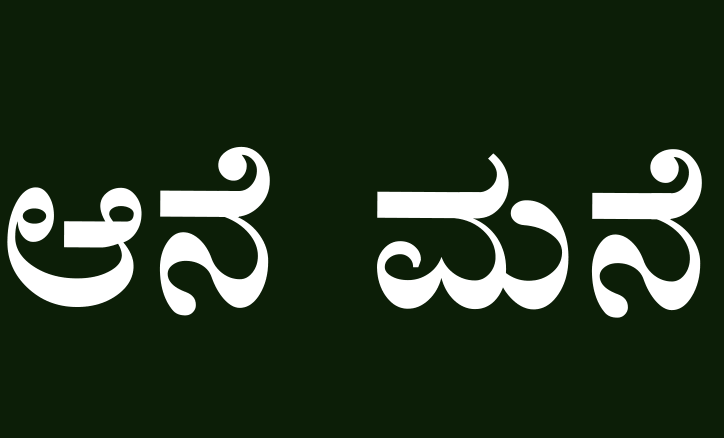

NEWS
April 2025 | A tribute to Siddha Mani JK (Jenu Kuruba) 1955 - 2025
%20corr.jpg?v=1k0ctf5)
Aya Mani or Siddhajja as we affectionately called him at the Aane Mane camp, was born in 1955, at Jone kathe, between the old Hebale elephant camp and the present Mathigod elephant camp, as his father, Ranga JK, was working as a mahout for the Karnataka Forest Department. When he was around two, his father and his mother Linghi moved to Dubare, where his father continued to work with his male elephant Subash until his retirement in 1970.
Aya Mani married at the age of 17 years with a young woman of his choice, Kuli, and started working with his brother-in-law, late Sana, as his kawadi (assistant mahout) on a keddah caught female elephant, Nirmala.
In 1978, he joined the Karnataka Forest Department, after he participated in the capture, and training of a male tusker of an estimated age of 20 years. The elephant was captured in pit No.4 situated before the Byrana Hole, in Dubare Reserved Forest along the Cauvery River, one of the last captures by pit method that was abandoned in 1979.
The elephant was left to graze freely in the forest, which is the best method of maintaining an elephant in good health as it is free to move, graze and browse. A year and a half later, his elephant decided to cross the Cauvery River, but the ring at the end of its drag chain got jammed between rocks. The elephant struggled all night to free itself and was found only in the morning search. Aya Mani along with other mahouts struggled to release the chain. The operation lasted hours and they finally brought the elephant to the camp. By evening it died of exhaustion.
Aya Mani was made responsible for the incident and was removed from his job. He carried this burden for the rest of his life, even when he worked with us as the Jamedar (the Chief mahout) of our elephant camp since 2012, as always when talking about his life experience with me, the death of the elephant would come up, as it had stripped him of his honour in the profession.
Today, as I hear of his death, aged 70, I want to pay homage to this simple man, his knowledge of the forest, his patience, his kindness. With him disappears another friend who carried the old values of the elephant people that I have learnt in the forests of India.
January 2025 | A Life Walking with Elephants: In conversation with Prajna Chowta, by Ramya Reddy

In this thought-provoking conversation, anthropologist, conservationist, and filmmaker Prajna Chowta shares a life shaped by the wild and guided by an unyielding curiosity. From her childhood amidst the raw beauty of Africa and India to becoming one of the rare female mahouts in India, Prajna’s story is a testament to the transformative power of kinship—with people, nature, and elephants. Through her work with indigenous Kuruba communities and her deep bond with elephants, Prajna offers profound lessons on care, connection, and coexisting with the natural world.
>> Read article
January 2024 | European release of THE ANDAMAN ELEPHANT ENIGMA
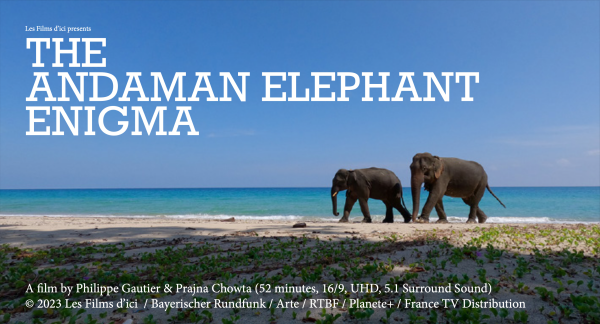
When in the 19th century, the European navigators began to explore the Andaman islands, there were none of the large mammals common to South Asia, including elephants.
Today, however, elephants are used in the extraction of timber and small herds live in the wild. How did they reach the islands and how were they able to regain new territories?
It is believed that in the Andamans, elephants swim in the sea from island to island. Is it a legend or a fact? Could they have reached the Andamans during the last ice age 25,000 years ago, like the aboriginal tribes still living on the islands today? The film investigates the enigmatic history of the Andaman elephants.
>> more
April 2022 | Publication of THE SOAS ELEPHANT READER, edited by Ed Emery
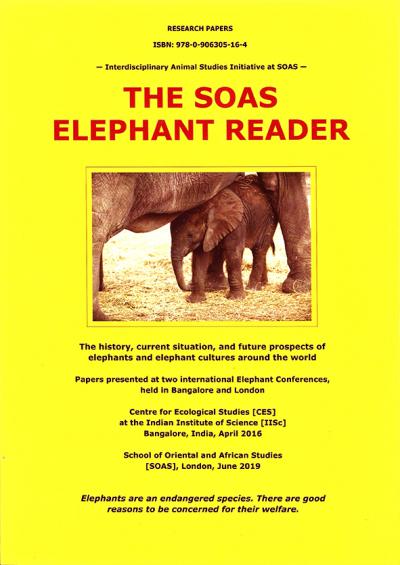
The SOAS ELEPHANT READER, edited by Ed Emery, was published by RN Books of London in May 2021. The volume includes the proceedings of the SOAS Elephant Conferences held at the Centre for Environmental Studies (CES) Bangalore, 4-6 April 2016, and at the School of Oriental and African Studies (SOAS) London, 22 June 2019.
This publication presents in 298 pages, a unique collection of 27 essays by as many elephant specialists in various disciplines, from history to genetics to ecology and in situ conservation.
Prajna Chowta of the Aane Mane Foundation has contributed two essays:
— Cultural aberrations in the management of captive elephants
— The legend of Palakapya
Copies of this book may be acquired by contacting
SOAS Bookshop, Thornhaugh Street, London WC1H 0XG
Email: bookshop@soas.ac.uk
October 2021 | Weaning and Training: two distinct processes, by Prajna Chowta
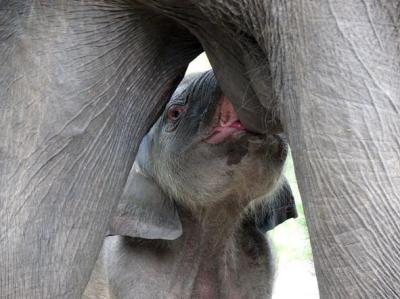
Traditionnally, captive elephant calves are separated from their mothers and weaned at the age of 2 or earlier (sometimes at 6 months !) so that the mother can be put back to work and the calf can be trained and controlled. It is much too early, sometimes fatal for the calf, with deficiencies of the immune system and traumatic consequences for both the calf and its mother. The mother's milk is essential for the growth and the development of the immune system, and suckling certainly has a role in the psychological balance of the animal. In natural conditions, calves suckle up to the age of 6. Experimentations undertaken at Aane Mane's camp with free-ranging elephants in their natural habitat show that there are other ways to handle and vaccinate a calf of 2 or more without having to wean it. >>more
September 2021 | The Birth of Ashwatthama
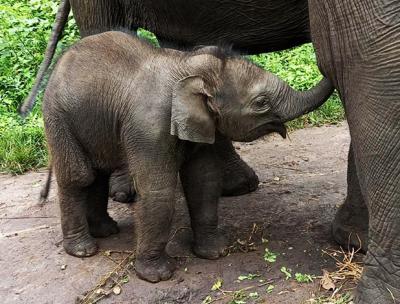
On the 14th of August 2021, Kalpana gave birth to her second calf in 19 years, a male of 91cm. He was named Ashwatthama and suckles both Kalpana and Kunti, a further proof that female elephants share responsibility for their calves.
In the Hindu epic the Mahabharata, Ashwatthama is the son of guru Drona who fought on the Kaurava side against the Pandavas in the Kurukshetra War. It is also the name of an elephant sacrificed to serve the intrigues of war.
August 2021 | Elephant Code Book: The first elephant management manual in Kannada
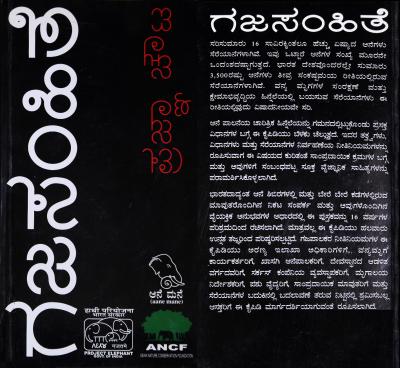
In the course of Indian history, treaties on elephants have been written in Tamil, Sanskrit and other languages using the Devanagari script, Perso-arabic, Assamese and English. None had ever been published in Kannada, although Karnataka state shelters today one of the largest populations of Asian elephants.
Prajna Chowta corrected this shortcoming by publishing a Kannada translation of her Elephant Code Book. This book is an update of all the necessary data for the management of elephants in captivity, including ecology, feeding, veterinary care, training of mahouts, elephant behaviour, legal status of the species, etc.
500 free copies were distributed among forest officers and mahouts in elephant camps across the state.
To order a copy, write to the Aane Mane Foundation here
August 2021 | Human Elephant Conflict: A collective responsibility
Every year in India, between 100 and 500 people are killed by elephants and many more lose part of their crops or have their property damaged. On the other hand, as many elephants are killed in retaliation (electrocution, poisoning, gunshots) or due to human activities (poaching, collisions with trucks or trains, falls in wells, trenches and canals). Over the years, a number of solutions have been implemented with various degrees of success. Still fatalities occur...
August 2021 | ElephanTTrackinG used in the mitigation of human-elephant conflict in Karnataka
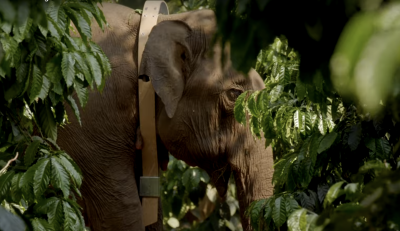
Among various methods used to mitigate the conflicts between humans and elephants, ElephanTTrackinG developed by the Aane Mane Foundation, which consists of GPS collars and a specific mobile app, allows to track wild elephants straying outside forest areas, map their movements and warn the public in real time.
February 2021 | Homage to Three Mahout Friends who Disappeared, by Prajna Chowta

Kura JK
I first met Kurana in 1995, a mahout working for the Karnataka Forest Department at Dubare elephant camp, when I came to choose his elephant Vikrama for the film "Hathi". The son of a mahout himself, he came from the heart of the Jenu Kuruba elephant tradition, the main centre of which, in his time, was Hebale camp, near Thittimati. His first experience was in the capture and training of elephants caught by the pit method. He ended his career taking care of Vikrama elephant, a tall tusker who was captured with tranquilizers and then trained in a kraal (corral). Kurana became my 'Dersu Uzala' when I settled in his region, he was my friend and guide into the elephant world of the Jenu Kurubas.

Mujeeb Khan
The first time I saw Mujeeb at work, it was in 1995, at Sakrebail elephant camp near Shimoga. He was the kawadi of a powerful elephant, New Tusker, who belonged to the Karnataka Forest Department. His relentless passion for elephants came from his father who participated in the last few Kheddas in the late 60’s and early 70's. Mujeeb participated in every elephant film that I was involved in till date, as a professional, reliable technical support in the tradition of elephant keeping and continued to work with elephants until his early demise last year. As a friend, he would sometimes say when we worked together: "I don't know what you do to them, but the elephants love you more than us, mahouts."
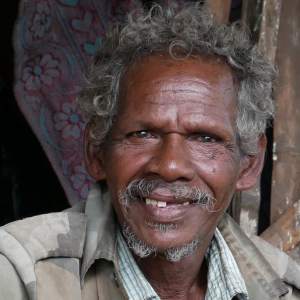
Chikka JK
Chikkana was born in Kalhala, across the Lakshman Tirtha river from Hebale camp, grew up and learned under his father, a mahout working for the Karnataka Forest Department. He started working for the Department in Mathigod camp, Thittimati, when his father passed away. When I met Chikkana 25 years ago, he was already working as the mahout of Harsha elephant, a large tusker who was captured at Katepura. Harsha never accepted any other mahout so Chikkana continued to take care of his elephant after his retirement and until his last days. With his death on the 24th of February 2021 in Mathigod ends an epoch, the spirit of a generation of mahouts, and his elephant Harsha will miss his dear friend Chikkana.
January 2021 | Republic Day of India parade in New Delhi

On the occasion of the Republic Day of India parade in New Delhi, the 26th of January 2021, Shashidar Adapa and his team created a tableau vivant presenting the State of Karnataka, featuring the Vijayanagar empire, seen as a golden era in the history of the Deccan.
Shashidar Adapa was inducted as a trustee of the Aane Mane Foundation in 2019.
May 2019 | The Karnataka Forest Department evaluates the effectiveness of ElephanTTrackinG after one year

'Deaths due to elephant menace in Hassan, Virajpet come down
Jumbos radio collared to monitor their movements'
(by Bosky Khanna, Deccan Herald)
Bengaluru, 19 May 2019: The human casualties due to human-elephant conflict in Hassan district and Virajpet taluk in Kodagu District has come down drastically in the last six months, according to the Forest Department...
August 2018 | Friend with Jumbos (by Prajna GR, Deccan Herald)
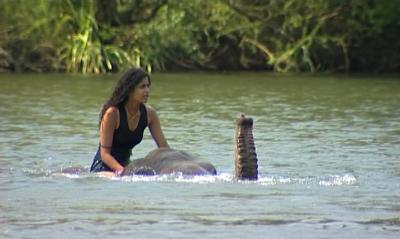
"Go, but don’t let go,” she says, “continue to dream and look for your freedom.” A vibrant personality who has broken ties with monotonous routine, Prajna Chowta has carved a niche as a researcher, conservationist and a documentary filmmaker...
March 2017 | Radhika Subramaniam at Aane Mane's camp
.jpg?v=1dr2bt4)
"I'm just back in NYC and feel very buoyed by the intense immersion of the last fortnight. The space you have created at the camp through your commitment to the well being and future not only of elephants but of elephant people is downright remarkable. It's not often one meets people who live their lives in such an integrated way.
Thank you too for the amazing hospitality—morning chai in the mists, evening beers under the stars, mid-day dosais in the sunshine—and a healthy dose of reality with a swarm of bees!
Warm regards and trumpets to all."
Radhika Subramaniam
Director/Chief Curator, Sheila C. Johnson Design Center
Asst. Professor, Parsons School of Arts / New York
February 2017 | Chevalier de l'Ordre National du Mérite
Film-maker and elephant researcher Prajna Chowta has been appointed Chevalier de l'Ordre National du Mérite (Knight in the National Order of Merit), one of the highest civilian recognitions of the French government.
The Hindu - article: "France confers knighthood on elephant researcher"
Consulat Général de France in Bangalore :
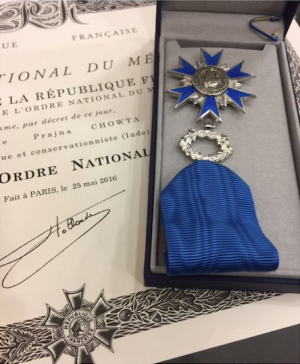
November 2016 | A Brief History of the Andaman Elephants, by Prajna Chowta
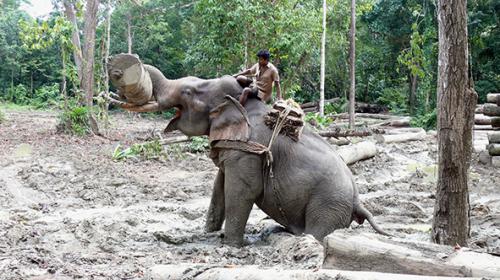
Abstract: Although Asian elephants (Elephas maximus) have been brought to the Andaman Islands since the second half of 19th century for the purpose of timber extraction in which they played a crucial role, no historical study was ever conducted on the origin of these animals, the number of specimens involved, the trade and industry they were involved in, their adaptation to a different habitat, the origin of the mahouts, their working methods and the conditions under which both mahouts and elephants worked and lived.
This essay explores this iconic chapter in the history of the species based on a field investigation in the major elephant camps and timber extraction sites in the islands as well as a study of the archives kept by the Forest Department, the Government Secretariat and the Cellular Jail library in Port Blair. It also questions the absence of wild elephants in the archipelago in early history, unlike Sumatra and Borneo, and discusses the Government policies regarding the management of captive elephants in India and the feral elephants of Interview Island and Diglipur. (Word count : 20,233)
For more information, write to us here.
April 2016 | The Elephant Conference by SOAS, University of London, at the Indian Institute of Science (IISc), Bangalore
The conference programme addressed all aspects of elephant culture, past, present and future and in all continents. It dealt with both material and cultural concerns, and covered both the Asian and the African elephant.
Prajna Chowta participated in the event with a talk titled : Cultural aberrations in the management of captive elephants.
Régis Debruyne was invited to expose the Contribution of comparative genetics to the understanding of the evolution and distribution of elephants.
January 2016 | Meet the herd
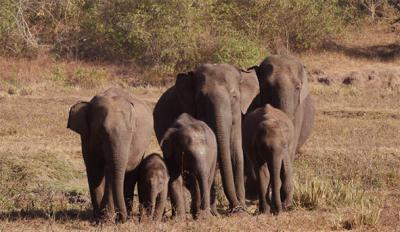
From left to right: Dharma (8 years), Kamali (3 months), Gaja (2 years), Kalpana (40 years), Kuja (3 years), Kunti (32 years).
They are more autonomous but still come back to camp on their own regularly to receive their supplement ration.
November 2015 | Fourth birth at Aane Mane
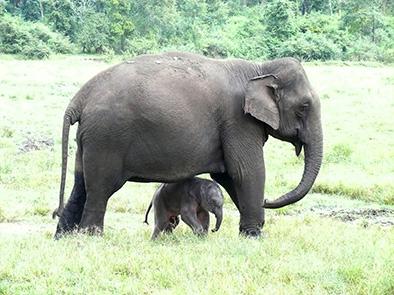
Kunti gave birth to her 3rd calf: a female born on November 2nd, 2015. She was 91 cm in height and was named Kamali.
February 2015 | ElephanTTrackinG, a complete wildlife tracking system

Designed by the Aane Mane Foundation in exclusive collaboration with GeoNative (France), ElephanTTrackinG is a complete wildlife tracking system that includes the latest technology available today.
ElephanTTrackinG was born from Aane Mane's determination to develop and share a tracking system for elephants in India. For us, GPS collars represent an indispensable tool to study the movements of wild elephants, but also a modern alternative to the historical practice of chaining tamed elephants, so that they may free-range in their natural habitat. Moreover, it can be used as an early warning system in the mitigation of Human Elephant Conflict, to prevent human casualties and damages to crops. >>more
October 2014 | Release of the book ENFANT D'ELEPHANTS (Elephants’ Child)
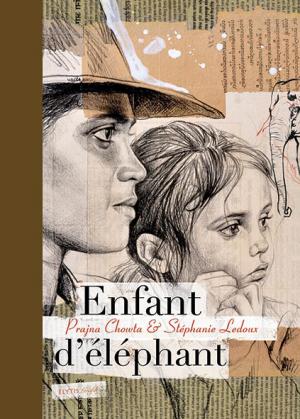
Text by Prajna Chowta
Illustrations by Stéphanie Ledoux
http://stephanie-ledoux.blogspot.in
Published by Elytis Edition
http://elytis-edition.com/catbeauxlivrespage.htm
ENFANT D'ELEPHANTS is the true story of Ojas, a little girl who lives in a forest in South India amongst elephants. She owes this childhood to her mother, Prajna, who left behind everything in search of the roots of her culture and lives with elephants, much like a hermit known in Indian mythology, Palakapya.
To fulfil this choice in life, Prajna had to walk away from society, from material comfort and even the idea of having a child. The arrival of Ojas turns her resolutions upside down. An infant of the forest, Ojas grows up in an environment that marks her imagination and forges her identity. Although, Prajna’s duty as a mother reminds her that she has to prepare her child to confront the human society, she tries to delay the moment when they both will have to set out to the very world that she chose to leave behind...
August 2014 | Elephant Blues selected at The World Film Festival, Montréal - Canada
International Distribution & VOD
DigiNext (New York, USA)
October 2013 | Third birth at Aane Mane

After 11 years at the camp, Kalpana has finally given birth to a male calf on the 22nd of October, at dawn. She is deeply involved in the care of her first calf, 93 cm at the shoulder and in perfect health. The calf was named Gaja (pronounced Gadja), which means 'elephant' in Sanskrit.
March 2012 | Second birth at Aane Mane
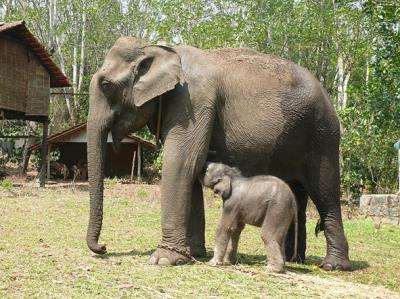
Kuja, a female, 90 cm at the shoulder, in perfect health.
Janvier 2012 | First elephant GPS collar made in India
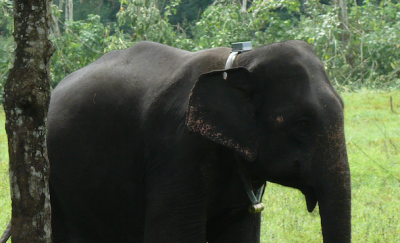
Aane Mane is proud to participate in the testing of the first prototypes of elephant tracking collars designed and made in India. The project was undertaken by two young electronic engineers, Radhika Gandhi and Bharath Patil, under the direction of Dr. André Pittet, Chief Advisor at the Center for Electronics Design and Technology (CEDT), Indian Institute of Science, Bangalore.
GPS collars may prove useful in the mitigation of human elephant conflict in areas where the elephant habitat is fragmented and occupied by human settlements.
October 2010 | Release of the ELEPHANT CODE BOOK by Prajna Chowta
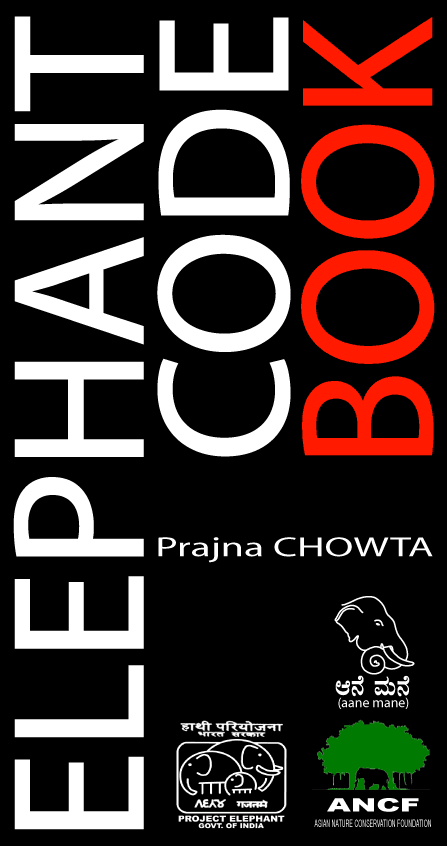
As many as 16,000 Asian elephants–one third of the entire population–are captive. In India alone, about 3500 elephants live in various and often critical conditions of captivity, contradicting the contemporary notions of wildlife conservation and animal welfare.
The Elephant Code Book examines the current methods of elephant keeping and recalls the historical background that is necessary to understand the present situation. It reviews the classical texts on the subject as well as the relevant scientific literature in order to define the principles, methods and minimum standards to be adopted as a code of conduct in the management of elephants in captivity. >>Download the Elephant Code Book here
ELEPHANT CODE BOOK by Prajna CHOWTA, 138 p. 2010. ISBN 978-81-909731-0-6.
Published by :
Asian Nature Conservation Foundation www.asiannature.org & Aane Mane Foundation, Bangalore, India.
Read May we have the trumpets please? by Savitha Karthik in The Deccan Herald
'City lights hold no charm for Prajna Chowta, who has her hands full running ‘Aanemane’, an elephant camp in the jungles near Mysore, documenting the moves of the majestic creatures and enjoying the sight of her four-year-old growing up in the lap of nature, writes Savitha Karthik...' >>Read online
July 2009 | Dharma is now 2 years old
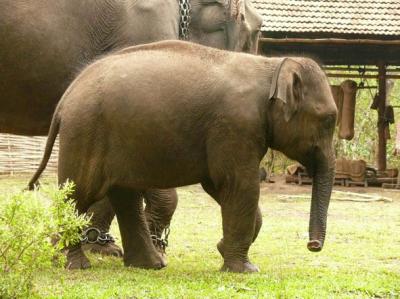
In two years, Dharma has reached 1.40m and around 500kg.
July 2007 | First birth at Aane Mane camp
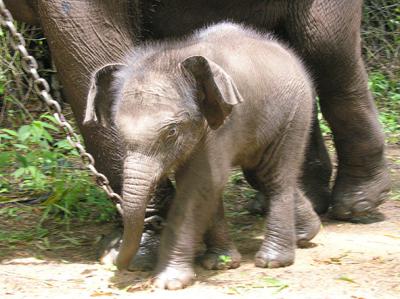
Dharma was born on 7/7/2007. An auspicious date!
He was a small male, 82 cm at the shoulder, approximately 90 kilos and the first elephant born at Aane Mane's camp
© Copyright 2008-2025 Aane Mane Foundation.
All rights reserved. Web design by Lor.

